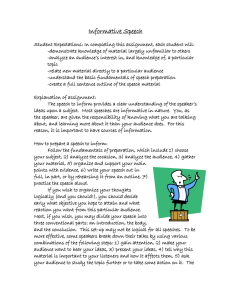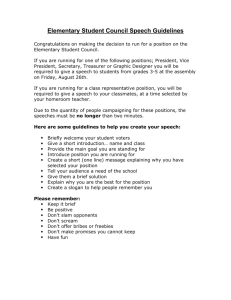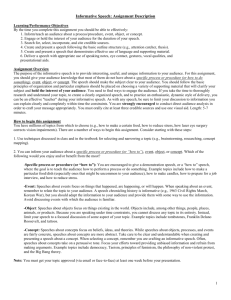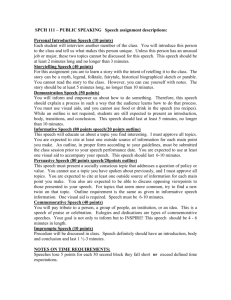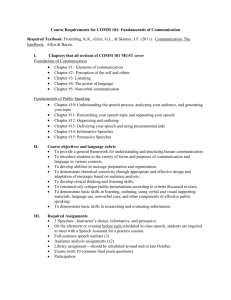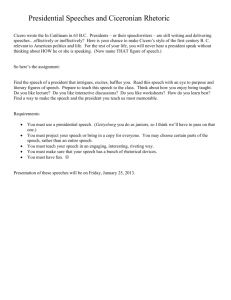Diversity and Inclusivity Innovation for COMM 210: Fundamentals of
advertisement
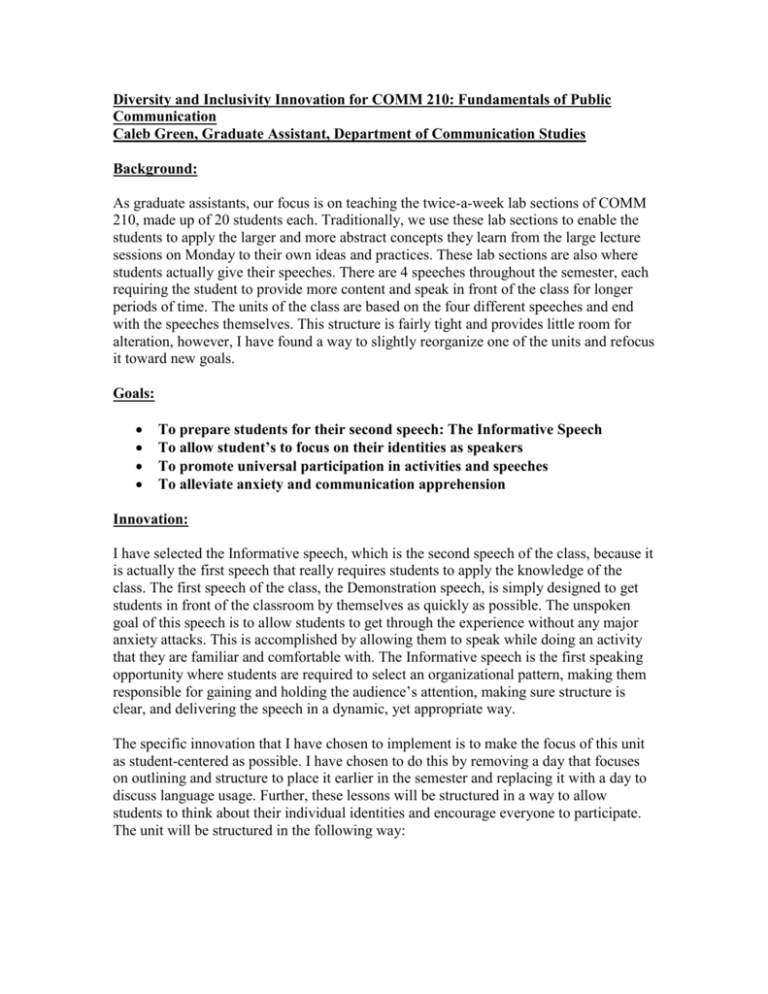
Diversity and Inclusivity Innovation for COMM 210: Fundamentals of Public Communication Caleb Green, Graduate Assistant, Department of Communication Studies Background: As graduate assistants, our focus is on teaching the twice-a-week lab sections of COMM 210, made up of 20 students each. Traditionally, we use these lab sections to enable the students to apply the larger and more abstract concepts they learn from the large lecture sessions on Monday to their own ideas and practices. These lab sections are also where students actually give their speeches. There are 4 speeches throughout the semester, each requiring the student to provide more content and speak in front of the class for longer periods of time. The units of the class are based on the four different speeches and end with the speeches themselves. This structure is fairly tight and provides little room for alteration, however, I have found a way to slightly reorganize one of the units and refocus it toward new goals. Goals: To prepare students for their second speech: The Informative Speech To allow student’s to focus on their identities as speakers To promote universal participation in activities and speeches To alleviate anxiety and communication apprehension Innovation: I have selected the Informative speech, which is the second speech of the class, because it is actually the first speech that really requires students to apply the knowledge of the class. The first speech of the class, the Demonstration speech, is simply designed to get students in front of the classroom by themselves as quickly as possible. The unspoken goal of this speech is to allow students to get through the experience without any major anxiety attacks. This is accomplished by allowing them to speak while doing an activity that they are familiar and comfortable with. The Informative speech is the first speaking opportunity where students are required to select an organizational pattern, making them responsible for gaining and holding the audience’s attention, making sure structure is clear, and delivering the speech in a dynamic, yet appropriate way. The specific innovation that I have chosen to implement is to make the focus of this unit as student-centered as possible. I have chosen to do this by removing a day that focuses on outlining and structure to place it earlier in the semester and replacing it with a day to discuss language usage. Further, these lessons will be structured in a way to allow students to think about their individual identities and encourage everyone to participate. The unit will be structured in the following way: WEEK ONE: Audience Analysis and Language WEEK TWO: Delivery WEEK THREE: Informative Speeches WEEK ONE: DAY ONE: Audience Analysis In the past, we have focused on making this day about explaining that only making choices based on the demographic make-up of an audience is bad and stress that students should focus on more situational analysis. I have decided to take this concept a step further by leading a class discussion on why it is bad and how we can avoid it. After explaining the two types of analysis, I will show commercials that employ demographic audience analysis in ways that lead to stereotyping. I will then lead a class discussion on why this is wrong and what kind of audience analysis questions the advertisers could have asked to focus on more situational and responsible advertising. I will then break up the class into groups and give each group a product to develop audience analysis questions for. I will then bring the class back together and ask a few groups to share their ideas. Outside of class, students will be asked to come up with as many audience analysis questions to ask our class as possible, hopefully allowing them to think of their topic for the upcoming speech. This will also require the students to think of their classmates and the differences and similarities between them. Hopefully, the students will avoid depending on stereotypes and actually learn about their classmates DAY TWO: LANGUAGE This day has two goals: to get students to think creatively about the way that we use language and to realize that language presents certain biases. I will focus be asking the students to break into groups. I will give each group an item and ask them to come up with as many different words to describe the item on their own. I will then ask them to pull their lists together as a group and then share them with the class. My goal is to get the students to see that they each think of different details and words to describe the same object. I also hope to put a focus on how our identities are reflected in the way we use language. The second goal will be achieved by telling a story about a doctor without using any gender pronouns. The students typically assume, incorrectly, that the doctor in question is a man instead of a woman. I then ask them to write down words to describe a sexually promiscuous male and female and we discuss which words are positive and which are negative, as well as which gender has the most names. Females usually have more names that are generally negative, while males are given a few labels that are generally positive. As an out-of-class activity, students will be asked to come up with words and labels that they hate hearing. Students will be asked to share one of these items at the beginning of class next week. Students will be asked to avoid obvious racial slurs, such as the “Nword,” and, I will make it a point that I trust them to know that this kind of language is not appropriate. This will allow the students to inform their classmates of their dislikes, as well as make all students aware of words and language that is upsetting or offensive to their classmates, which will hopefully allow our students to better understand themselves and each other. WEEK TWO: DELIVERY DAY ONE: We will begin with the discussion of language that we do not like. I will sit down in a circle with the students and ask them to provide a word during role call. We will then spend however long we need to discuss these words and how to respect each other’s feelings in regards to language. To practice delivery, I usually allow students to get in front of the class and actively participate in activities to loosen them up and allow them to practice their delivery. This has historically been more difficult for students that are shy, which tend to be students that come from less populated areas and have petite bodies. I will attempt to refocus these activities on making everyone comfortable by making myself a more active participant in these activities, as well as attempting to level the physical playing field. On the first day, we will participate in “speech crimes” in which the students are given certain delivery mistakes (looking at the floor, playing with hair, etc.…) and a topic to talk about while acting these out in front of the class. In order to promote comfort and participation, I will give each student a “lifeline” by allowing them to ask me to act out the speech crime, but, only after they have tried to act out the situation for AT LEAST 15 seconds. This will hopefully provide the students with an appropriate safety net and alleviate the anxiety of participation. This activity can also occur on day two if we need more time to discuss language. Outside of class, students will be asked to prepare a skeletal outline of their speech, employing the information that they have gathered about their class from week one. DAY TWO: The last activity that I employ to practice delivery is called “Save the World.” In this activity, students write down one item and one problem, and swap them randomly. They are then asked to construct a short speech about how they can use their item to save their problem. Students usually come up with general problems such as world hunger and use items that they see in the room or that the teacher provides. I will refocus this activity on the students by asking them to come up with a problem that directly affects them and to provide an item that they have in their own bedrooms. This will allow students to provide elements of their identity to class, highlighting their individuality. Also, instead of being forced to give this speech in front of the class, students will be asked to give this speech from their seats, which will be arranged in a circle. This will hopefully allow for all students to feel welcome to participate, as I will hopefully eliminate any advantages that students with more expressive bodies and confidence have when attempting to foster participation and communication with the class. Outside of class, students will be expected to finalize their speeches and asked to practice them in some way at least twice. WEEK THREE: INFORMATIVE SPEECHES This week will serve as the evaluation point for the unit, determining if students were able to put all of the tools together that will allow them to presents their identities in a public speaking context in a way that also considers their classmates’ identities and feelings. The speeches will be graded by the rubric that all graduate assistants are required to use in the course.


